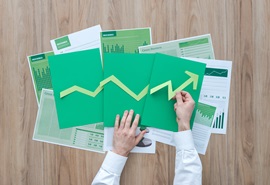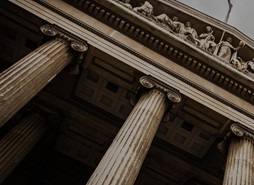Bringing Investors and Companies Together to Address the Climate Change Crisis
As Earth Day is around the corner on the 22nd of April, the Biden Administration is to convene a global climate summit. Following a historical precedent for several such events, since its inception in 1970, including signing the landmark Paris Agreement . We have seen positive developments since the Paris Agreement; societal actions to address some of the root causes of climate change have yet to suppress the negative trends . Historically, active ownership on climate change has focused on direct emissions from highly exposed sectors, such as fossil fuel and utility companies. However, the more complicated, less direct aspects of climate change have seen limited progress. Tackling such issues will see a strong need for collaboration from both countries and other key sectors, in particular, banking and finance. Banks are key to support this transformation; facilitating economic activity for positive change throughout the entire value chain is key.
Sustainability-Linked Loans 2021: The COVID-19 Effect, ESG Ratings & Continued Popularity
The sustainable finance market has seen an exponential increase in size and activity in recent years. Innovative offerings such as green, social, and sustainable bonds, green and sustainability-linked loans (SLLs), and most recently sustainability-linked bonds, have contributed to the market’s incredible growth. In 2020, boosted by varied financial needs and mainstream recognition of environmental, social and governance (ESG) parameters, global sustainable debt capital surpassed US$700 billion, a 30% increase compared to 2019. Part of this capital was channelled towards tackling the effects of COVID-19 as government agencies, supranational bodies and corporates borrowed money to support areas most affected by the pandemic, such as healthcare. This shift in fund usage in 2020 resulted in the rapid growth of social bonds and a commendable first year for sustainability-linked bonds.
Sustainability-Linked Bonds
What are Sustainability-Linked Bonds? Sustainability-Linked Bonds (SLB) are a forward-looking performance-based instrument. The bonds financial or structural characteristics (such as the coupon rate) are adjusted depending on the achievement of pre-defined sustainability targets. The adjustment can be in both directions, e.g., an increase in coupon rate if targets are not met or a decrease in coupon rate if targets are met. The key difference with green/social/sustainability bonds is that the proceeds can be used for general corporate purposes.
What are Sustainability Linked Loans (SLLs)?
A Sustainability Linked Loan is focused on incentivizing sustainability improvements among corporate borrowers by linking the terms of the loan to their overall sustainability performance targets. SLLs can be used for general corporate purposes as the terms are tied solely to the borrower’s ESG-related performance.
Sustainable Banking Insights
An increasing number of financial institutions integrate sustainability considerations such as environment, social and governance factors into their investment decisions and product development. Increased customer awareness, regulations, and growing evidence of the long-term benefits of considering sustainability in investment decisions has led to a significant growth in the sustainable finance field.
Aligning Finance and Sustainability: The Role of the Principles for Responsible Banking
The Principles for Responsible Banking requires banks to take a hard look at their business strategies and their impacts on the environment and society. For this reason, Sustainalytics has endorsed the Principles for Responsible Banking and has committed to working closely with banks as they seek to further incorporate sustainability considerations throughout their operations.
Generali Green Bond Framework and Second-party opinion
Assicurazioni Generali SpA (“Generali” or the “Group”) is a global insurance and financial services company based in Italy. Founded in 1831, Generali now operates in over 60 countries with approximately 71,000 employees and is one of the world’s largest insurance providers by revenue. It is well positioned in the insurance business, and with its asset management business in Europe, with a growing presence in Asia and Latin America. In addition to Generali’s three strategic pillars – profitable growth, capital management and digital transformation – Generali established sustainability as a key initiative and one of its important goals for 2021 (Read more: https://www.generali.com/our-responsibilities).
Introduction to Sustainability-Linked Loans and ESG Ratings
Sustainable finance and green lending are on the rise as more borrowers and lenders recognize the potential benefits of green and sustainability-linked loan products for their businesses. According to the Loan Markets Association (LMA), sustainability linked loans are a "dynamic and innovative product that enables lenders to incentivize improvements in the borrower's sustainability profile.” Sustainability linked loans align the loan terms to the borrower's performance against pre-determined sustainability performance targets such as a company’s ESG rating. Learn more about ESG Ratings
Sustainable Development Goals – Green Financing as a Bridge to the SDGs
The purpose of green financing, as stated by the UN Environment Programme, is to increase the level of financial flows (from banking, micro-credit, insurance and investment) from the public, private and not-for-profit sectors to sustainable development priorities. The aim is to align financial systems, working with countries, financial regulators and financial sectors, to direct capital allocation to sustainable development that will shape the production and consumption patterns of tomorrow. Financial mechanisms such as Green Bonds help this alignment as they promote public-private partnerships for sustainable development.
Demystifying Sustainability Linked Loans: Leverage your ESG Rating
While investors are increasingly focused on how their investment decisions impact the environment and key stakeholders, forward-looking lenders also have sustainability at the core of their allocation strategies. As a result, the demand for sustainable finance products has increased in recent years.
Taxonomies and Regulation: Signs of a Maturing Market
Global regulatory initiatives for sustainable finance will be in the spotlight this year. The European Commission’s regulatory initiatives have been the most prominent. Following on the findings of the High-Level Expert Group on Sustainable Finance (HLEG), the European Commission put together a Technical Expert Working Group on Sustainable Finance to implement some of the HLEG’s recommendations. First on its list is the creation of a green taxonomy, which is expected by the second quarter of 2019 and will be followed by a green bond standard.
















